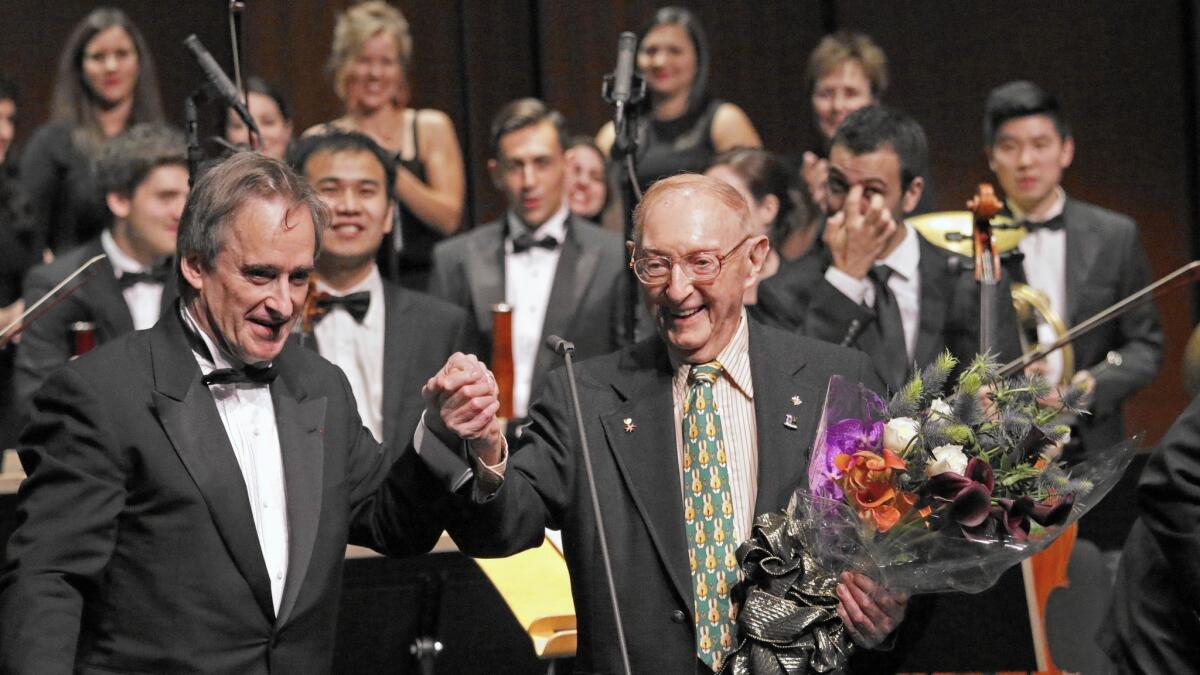Review: ‘The Poet in Exile’ at the Wallis lacks full picture of Walter Arlen

In summer 1979, an emerging 29-year-old conductor was invited back to the Hollywood Bowl after having made his successful debut in the amphitheater with the Los Angeles Philharmonic two years earlier.
This time, however, the review in these pages was less glowing. Walter Arlen wrote that James Conlon’s “businesslike conducting failed to stimulate an enthusiastic response from the orchestra.”
Wednesday night, Arlen, now 95, was again in the audience to hear Conlon conduct. And also to accept praise from the now popular music director of Los Angeles Opera.
SIGN UP for the free Essential Arts & Culture newsletter >>
What had not been known in the nearly 30 years that Arlen reviewed concerts for The Times was that he was a frustrated composer. His composing block went away shortly after Arlen stopped reviewing in 1981.
The Wallis program, the first in a new collaboration between the Beverly Hills venue and the downtown Colburn School, was called “The Poet in Exile: The Music of Walter Arlen.” Conlon conducted and served as the master of ceremonies.
As a champion for a generation of composers who were victims of Nazi Germany and whose music has subsequently been neglected, the conductor told the audience he had been thrilled to learn about Arlen, whom he finally met recently at, of all places, a Starbucks at the Grove.
The teenage Arlen, then Walter Aptowizer and a budding composer, escaped Vienna in 1939 just as the storm troopers were at the door. Arlen’s composing ambitions were stalled when he first arrived in Chicago, but he was eventually taken under the wing of the American composer Roy Harris.
Arlen followed Harris to UCLA in 1951, where the Los Angeles Times music critic Albert Goldberg also taught. One thing led to another, and Arlen — while ranging widely on the musical scene (he once memorably called folk-singing Rabbi Shlomo Carlebach “the Elvis Presley of the Torah”) — became The Times’ go-to critic in contemporary music under Goldberg and later Martin Bernheimer.
Arlen also distinguished himself from The Times’ chief critics by his close personal involvement in the émigré community of composers. He is said to have never missed a Stravinsky rehearsal. The Wallis program, which featured Colburn students and alumni, began with a wonderfully loving musical tribute to Arlen by the Italian émigré Mario Castelnuovo-Tedesco, who died in 1968, and a wonderfully loving tribute that Arlen composed in memory of the French émigré, Darius Milhaud.
Certainly “‘Ein Quartett-Satz’ on the Name of Walter Arlen” — a string quartet movement of lyrical charm that mixes bits of Schubert with Arlen-derived musical motives and part of Castelnuovo-Tedesco’s series of pieces he called “Greeting Cards” — speaks of the regard the Italian composer had for Arlen.
“Saudades Do Milhaud: Collage Musical,” which comes from Arlen’s 1993 “Monotypes,” played by 14-year-old Andrew Zhao, makes a merry mess out of Milhaud’s easygoing Brazilian-inspired piano music.
Both of these pieces offered a sense of Arlen’s compositional crises during his years writing for The Times. As he chronicled the new music scene in L.A., and particularly that of progressive composers, he found his Old World tendencies in conflict with an avant-garde, both American and European. For the already established previous generation of émigrés, such as Castelnuovo-Tedesco and Milhaud, or Americans like the populist Harris), that was far less of a problem.
In what was surely a coincidence but also timely irony, this Arlen tribute happened to come just as Conlon was rehearsing the Los Angeles Opera production opening Saturday of “Moby Dick” by Jake Heggie, a student of and later husband of Harris’ widow, pianist Johana Harris.
Unfortunately little real useful context was given to the Arlen tribute, which appeared to be carelessly thrown together by the Colburn School. The main body of the program consisted of three vocal works. Though a gifted public speaker, Conlon was unusually unprepared for his remarks and missed a real opportunity in not inviting Arlen onstage for a conversation.
Particularly dubious was his explanation about the 1991 song cycle “The Poet in Exile” for solo baritone and instrumental ensemble. Rather than conduct the work with a Colburn ensemble as noted in the program book, Conlon said the composer preferred it with just piano (something Arlen would not confirm). Instead, baritone veteran Christian Immler sang accompanied by Audrey St. Gil, an L.A. Opera rehearsal pianist who learned the score at the last minute.
This should have been the key work in the program, a gloomy examination of the issues an émigré artist faces in a foreign land. The texts are by the Polish poet Czeslaw Milosz. Immler sang in single-purpose heraldic mode, making mush of the words. Colburn supplied no texts to the audience. The unfortunate effect was of an émigré howling to the wind.
The other two works were Arlen’s surprisingly sensual look at ancient times. In “Three Dead Sea Scroll Fragments” from 1989, he used elegantly concise harmonic means (harmony and melody being Arlen’s greatest gift) for an a cappella chorus (L.A. Choral Lab conducted by Michael Alfera).
The evening’s curiosity was “The Songs of Songs,” for three vocal soloists, women’s chorus and ensemble, the one piece that Conlon ended up conducting. Written in 1955, shortly after Arlen began at The Times, the half-hour score, never before performed, ranges from beguiling Hollywood exoticism to something more voluptuously, sexually, Viennese.
Along with Immler, the soloists were mezzo-soprano Lacey Jo Benter and tenor Rodrick Dixon (who had the thankless task of singing only in the last two minutes of the piece — and concert). Conlon, businesslike in a purposely useful sense, captured the music’s allure. But again lacking texts, the audience was often in the biblical dark.
As a critic, Arlen could be quite unforgiving when the basics of concerts were not thought through. It is a good thing he was not reviewing.
More to Read
The biggest entertainment stories
Get our big stories about Hollywood, film, television, music, arts, culture and more right in your inbox as soon as they publish.
You may occasionally receive promotional content from the Los Angeles Times.











